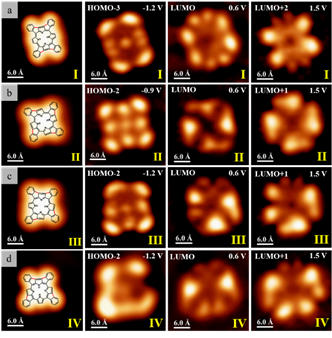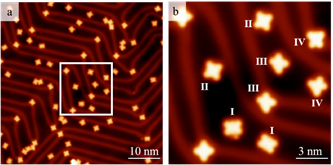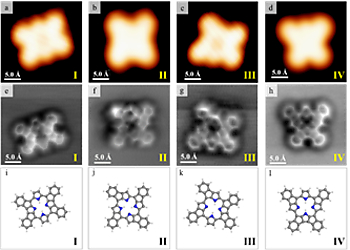Identifications and Electronic Characterizations of Four Cyclodehydrogenation Products of H2TPP Molecules on Au(111)
Result of the Month
To access the exact chemical structures and formation of four cyclodehydrogenation products, high-resolution STM and constant-height frequency-shift nc-AFM using a CO-functionalized tip combined with DFT-optimized model were performed (see methods for more detail information). STM images (Figure 3a-d) distinctly reveal that the four products adopt a planarized adsorption behavior. In Figure 3e-h, the structural conformations of four products (I, II, III, IV) are manifested in the constant-height nc-AFM images. Particularly, the four five-membered rings in the molecular backbone can be vaguely observed, which are originated from the dehydrogenation of eight carbon atoms in the molecule, with the formation of four new aryl–aryl carbon bonds between phenyl substituent and inter pyrrole core of porphyrin macrocycle. Figure 3i-l exhibit four corresponding DFT-optimized cyclodehydrogenation H2TPP products (I, II, III, IV), which are in good agreement with experimental results (Figure 3a-h). The combination of high-resolution STM images with bond-resolved nc-AFM images gives rise to the supporting evidence of the formation of four cyclodehydrogenation products.

Figure Discription: dI/dV maps of four H2TPP cyclodehydrogenation derivatives. Topography (left) and simultaneously acquired constant-current differential conductance (dI/dV) maps corresponding to different orbital states. Tunnelling parameters: STM images (Vb = -0.5 V, It = 200 pA); the bias voltages of dI/dV maps are recorded in the upper right corner, I-setpoint for all maps: 200 pA.
Experimental Section
All experiments were performed with STM (Scienta Omicron) under ultra-high vacuum (UHV) of below 1 × 10-10 mbar and the temperature of 4 K. Single crystal Au (111) was sputtered by Ar+ (1000 V) about the pressure of 5 × 10-6 mbar and then annealed at 673 K for 20 minutes. 5,10,15,20-tetraphenyl-21H, 23Hprophine (H2TPP) molecule (Sigma-Aldrich, purity 99.9%) was evaporated from Knudsen cell and deposited onto an atomic clean Au(111) surface maintained at room temperature. The prepared sample was annealed to 573 K for 20 minutes. All STM images were obtained by electrochemically corroding tungsten tips. STM images were analyzed by WSxM software. The CO molecule were in situ dosed into the sample at about 4 K through the leak valve, and the pressure was kept at 2 × 10-8 mbar for 4 minutes. CO-functionalized tip was prepared by picking up CO molecules from NaCl islands on Au(111) by approaching down the STM tungsten tip about -0.6 nm with negative voltage (-1 V). NC-AFM images were recorded in a constant-height frequency modulation mode (resonance frequency of 26 kHz, quality factor of about 22000).

Figure Discription: Cyclodehydrogenation products of H2TPP after annealing at 573 K on Au(111). (a) Large-scale STM topography image of the reacted monomers distributing randomly on surface (Vb = -1 V, It = 30 pA). (b) Zoom-in STM image of four derivatives (I, II, III, IV) in (a) marked by a white square (Vb = -0.5 V, It = 100 pA).
Discussion
In order to achieve different configurations of dehydrogenated H2TPP products, ring-closure reactions took place after annealing the sample above to 573 K for 30 mins and resulted in a significant change compared to the results in Figure 1a (as shown in Figure 2a). Firstly, the coverage reduction of molecules can be easily distinguished, which may be attributed to the desorption of H2TPP molecules from Au(111) surface during the elevated temperature process. Secondly, all monomers adopt a way of monodisperse distribution on Au(111) surface and prefer to absorb at the elbow site of Au(111) reconstructions. Thirdly, surface assisted cyclodehydrogenation induced all products to adopt a flat conformation compared with that before annealing. Four different configurations of dehydrogenated H2TPP products (I, II, III, IV) are found in Figure 2b corresponding to the magnified white square area in Figure 2a, which are in good agreement with previous results.
Additional Information
Authors:
Jianchen Lu, Binbin Da, Wei Xiong, Renjun Du, Zhenliang Hao, Zilin Ruan, Yong Zhang, Shijie Sun, Lei Gao and Jinming Cai
Institutes:
a) Faculty of Materials Science and Engineering, Kunming University of Science and Technology, Kunming, Yunnan 650093, China.
b) Faculty of Science, Kunming University of Science and Technology, Kunming, Yunnan 650093, China.
Corresponding Author:
Jinming Cai
Email: j.cai@kust.edu.cn

